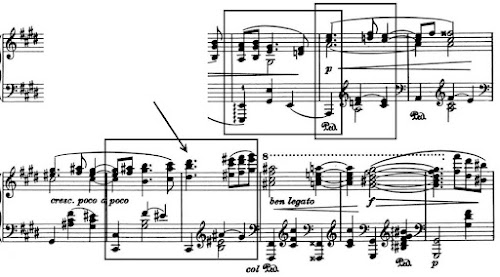In the previous post I showed the direct resolutions of the dominant major ninth (in nos. 2, 7, and 16), plus two others in no. 2. Here are the treatments elsewhere in the set.
The figure 9-8-7, very common in the waltz (especially Ländler) repertoire, occurs three times.
In no. 5 (see second system, second box; figure repeated in the final cadence):
I will discuss the other figures later in this post.
In no. 6 (three times via series of unfolded thirds):A similar figure in no. 7 covers 10-9-8:
Now, to those other figures in no. 7. At (a), the cadence has no dominant ninth. The shape is repeated at (b)--and (b) is repeated, transposed and slightly altered, at (c)--and in these cases there is a ninth forming a major dominant ninth chord. The resolution, however, is ascending: C#5 goes to D#5 in the first instance and F#5 goes to G#5 in the second instance. I don't want to get into the problematic matter of influence, but in this one case I will venture to assert that Brahms borrowed this ascending gesture directly from Schubert. Note, too, that the ascending stepwise line from ^5 to ^8 is repeated in the final cadence against the 9-8-7 figure (see beamed notes in the left hand at (d)).
Where my first examples (in Part 1) came from the last waltz, my last examples come from the first, where we find (1) a variant of the (10)-9-8-7 figure in the closing cadence (box at the end), and (2) what I hear as a "just barely" sounding of the ninth in grace notes (boxes in the first and second systems), a characterization that is also justified in that the piece is played without pedal (left-hand staccati preclude it).






